The Hippo tumor suppressor pathway regulates intestinal stem cell regeneration
- PMID: 21098564
- PMCID: PMC2990205
- DOI: 10.1242/dev.060483
The Hippo tumor suppressor pathway regulates intestinal stem cell regeneration
Abstract
Identification of the signaling pathways that control the proliferation of stem cells (SCs), and whether they act in a cell or non-cell autonomous manner, is key to our understanding of tissue homeostasis and cancer. In the adult Drosophila midgut, the Jun N-Terminal Kinase (JNK) pathway is activated in damaged enterocyte cells (ECs) following injury. This leads to the production of Upd cytokines from ECs, which in turn activate the Janus kinase (JAK)/Signal transducer and activator of transcription (STAT) pathway in Intestinal SCs (ISCs), stimulating their proliferation. In addition, the Hippo pathway has been recently implicated in the regulation of Upd production from the ECs. Here, we show that the Hippo pathway target, Yorkie (Yki), also plays a crucial and cell-autonomous role in ISCs. Activation of Yki in ISCs is sufficient to increase ISC proliferation, a process involving Yki target genes that promote division, survival and the Upd cytokines. We further show that prior to injury, Yki activity is constitutively repressed by the upstream Hippo pathway members Fat and Dachsous (Ds). These findings demonstrate a cell-autonomous role for the Hippo pathway in SCs, and have implications for understanding the role of this pathway in tumorigenesis and cancer stem cells.
Figures
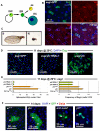
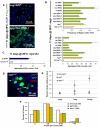
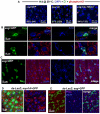
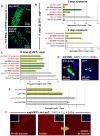
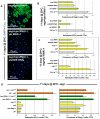
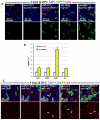

Similar articles
-
The Hippo pathway regulates intestinal stem cell proliferation during Drosophila adult midgut regeneration.Development. 2010 Dec;137(24):4147-58. doi: 10.1242/dev.052506. Epub 2010 Nov 10. Development. 2010. PMID: 21068063 Free PMC article.
-
The sterile 20-like kinase tao controls tissue homeostasis by regulating the hippo pathway in Drosophila adult midgut.J Genet Genomics. 2014 Aug 20;41(8):429-38. doi: 10.1016/j.jgg.2014.05.007. Epub 2014 Jun 19. J Genet Genomics. 2014. PMID: 25160975
-
A feedback loop between Paxillin and Yorkie sustains Drosophila intestinal homeostasis and regeneration.Nat Commun. 2025 Jan 10;16(1):570. doi: 10.1038/s41467-024-55255-1. Nat Commun. 2025. PMID: 39794306 Free PMC article.
-
A role for Hipk in the Hippo pathway.Sci Signal. 2013 May 14;6(275):pe18. doi: 10.1126/scisignal.2004259. Sci Signal. 2013. PMID: 23674821 Review.
-
Intestinal stem cell response to injury: lessons from Drosophila.Cell Mol Life Sci. 2016 Sep;73(17):3337-49. doi: 10.1007/s00018-016-2235-9. Epub 2016 May 2. Cell Mol Life Sci. 2016. PMID: 27137186 Free PMC article. Review.
Cited by
-
Notch-mediated suppression of TSC2 expression regulates cell differentiation in the Drosophila intestinal stem cell lineage.PLoS Genet. 2012;8(11):e1003045. doi: 10.1371/journal.pgen.1003045. Epub 2012 Nov 8. PLoS Genet. 2012. PMID: 23144631 Free PMC article.
-
Emerging role of Hpo signaling and YAP in hepatocellular carcinoma.J Hepatocell Carcinoma. 2015 Jun 18;2:69-78. doi: 10.2147/JHC.S48505. eCollection 2015. J Hepatocell Carcinoma. 2015. PMID: 27508196 Free PMC article. Review.
-
Gastrointestinal stem cells in health and disease: from flies to humans.Dis Model Mech. 2016 May 1;9(5):487-99. doi: 10.1242/dmm.024232. Epub 2016 Apr 25. Dis Model Mech. 2016. PMID: 27112333 Free PMC article. Review.
-
Impact of interactions between normal and transformed epithelial cells and the relevance to cancer.Cell Mol Life Sci. 2012 Jan;69(2):203-13. doi: 10.1007/s00018-011-0806-3. Epub 2011 Aug 30. Cell Mol Life Sci. 2012. PMID: 21877117 Free PMC article. Review.
-
Functions of the Drosophila JAK-STAT pathway: Lessons from stem cells.JAKSTAT. 2012 Jul 1;1(3):176-83. doi: 10.4161/jkst.21621. JAKSTAT. 2012. PMID: 24058767 Free PMC article. Review.
References
-
- Basler K., Struhl G. (1994). Compartment boundaries and the control of Drosophila limb pattern by hedgehog protein. Nature 368, 208-214 - PubMed
-
- Beebe K., Lee W. C., Micchelli C. A. (2010). JAK/STAT signaling coordinates stem cell proliferation and multilineage differentiation in the Drosophila intestinal stem cell lineage. Dev. Biol. 338, 28-37 - PubMed
Publication types
MeSH terms
Substances
Grants and funding
LinkOut - more resources
Full Text Sources
Medical
Molecular Biology Databases
Research Materials
Miscellaneous

